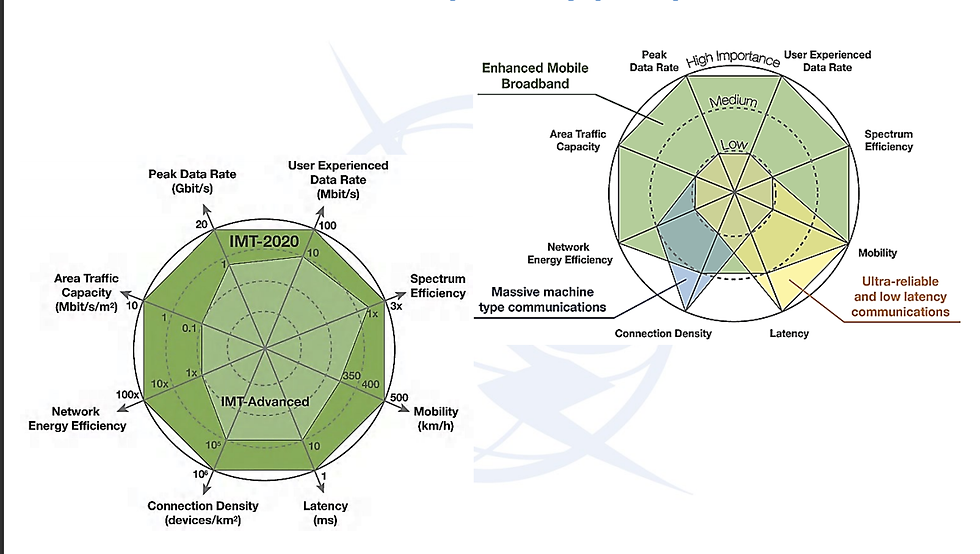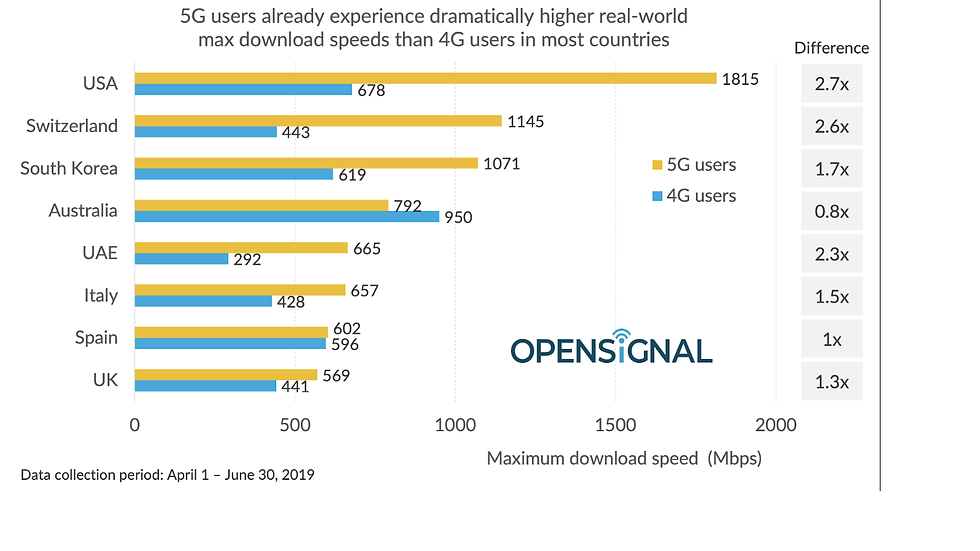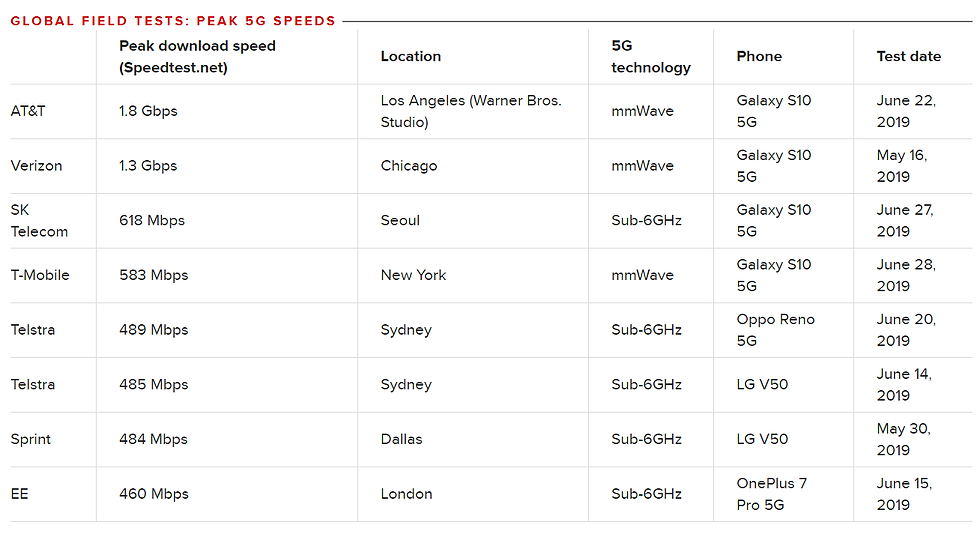Following the "consultation in relation to the assignment of spectrum in the 700 MHz, 3.6 GHz and 26 GHz band" issued by the Malta Communication Authority three local operator (Epic, GO and Melita) expressed their interest in offering the service on the island.
What is 5G?
With 4G we are already very much familiar with having high speed data on our mobiles. 5G represents an evolution of radio standard and it should allow higher speeds, lower latency and a better battery management of our mobile devices.
5G, according to ITU
The requirements for 5G were formulated by ITU(a standardisation body) in a set of recommendations called IMT-2020.
Three use cases were identified:
"Higher Speed": referred to as "Enhanced Mobile Broadband" (in reality covering also a better use of the radio spectrum, higher energy efficiency and offering the possibility of performing handover from one cell to another while travelling on a high speed train).
"Lower Latency": referred to as "Ultra-reliable and low latency communication"
"IoT": referred to as "Massive machine type communications" (mainly offering the possibility of connecting a very high number of devices to the same base station.
Here a comparison of the ITU requirements for 5G (called IMT-2020) versus the ITU requirements for 4G (called IMT-Advanced):

The reality of 3GPP
3GPP represents a consortium of manufacturers of telecom equipment (radio stations).They translate into a technical reality the requirements of ITU and they aim at launching to market the first commercial products that could be qualified as "5G". This even if not all the use cases are implemented at launch, and typically the use cases being prioritised is the one related to speed.
How fast will 5G be?
Actual speed on a mobile network will always depend on several different factors. In a cellular service the area covered is divided in "cells" centred around a specific antenna: as a consequence the maximum speed available for an end user is in reality shared between users in the same cells. In addiction to it 5G defines three distinct frequency bands and not all bands will provide the same speed results
As an example we can refer to data captured from Open signal and speedtest.net. Here we can see that the actual speed that customer will experience would be significantly higher that the one available over 4G with a (old) record established by AT&T of a mobile data speed of 1.8Gbps (note: more recent record in the millimetric waves are 4.5G/s by Turk Telekom and 5.23G/s by Samsung)


Why can 5G speed results vary so much?
The speed results reported differ, since not all countries have deployed millimetric vawes. What does it mean: 5G is a "standard" for mobile broadband data, based on three very distinct frequency bands:
Low Band 5G, centred around 750Mhz , for the best coverage. These frequencies are comparable to one of the frequencies currently used by GSM and DTTV: they penetrate walls easily and would require less antennas to cover a large area. This is one of the reason why in in order to "free up" resources in this frequency band DTTV and 2G are being discontinued in many countries. Low Band 5G would most likely enable speeds in the range between 50Mb/s and 250Mb/s
Mid Band 5G, centred around 3.6GHz for Gigabit/s speed. These frequencies are roughly comparable to the frequencies currently being used by Wi-fi Hotspots: this Band would allow top speeds up to 1 or 2Gbit/s but would have the same difficulties in penetrating walls as Wifi. Most likely this frequency will be used in densely populated areas like squares, schools stadiums and shopping malls.
High Band, 5G, centred around 26Ghz, for speeds up to 10G/s Giga These frequencies, the famous "millimetric waves" should enable the highest speeds required by the standard but would have very limited coverage and will not be able to offer indoor coverage. Most likely this set of frequencies will be used only in very dense areas like stadiums, airports or shopping malls and since it would require a large number of antennas most likely it would not be used for covering large areas.
In general he speed indicated by 5G trails indicate the speed of the radio link that connects your device to the base station. The real speed that a user will experience will also depend on other factors like:
the congestion of the "backhaul" (the connectivity link that provides data connectivity between the base station and the Core Network of your operator.
the quality of the coverage ( since speed will be affected by Signal to Noise Ratio)
the speed of the server we will be connected to
Will 5G introduce new dangerous frequencies?
Not really, two of the three frequency bands that 5G will use are not new, since they have been already used to deliver Mobile telephony, DTTV or Wifi: 5G will only represent a new and more efficient way to use that spectrum in order to deliver higher internet speeds and it will not represent any additional risk.
Will 5G be environment friendly?
Under some circumstances, 5G will help reducing the emission of a mobile network.
5G refers to a technology used in a RAN (Radio Access Network): the radio structure connecting users to a base station. In order to provide a service the RAN needs to work together with a number of other components located in the Core.
Currently many operators are still mantaining the infrastructure (Radio Access Network and Core) required to support 2G (the "normal" GSM we are all familiar with), 3G (a slower version of mobile internet we used to have around 2008) and 4G.
5 G could be deployed in two ways:
Standalone: a 5G RAN will de deployed together with a 5G Core.
Non- Standalone: a 5G RAN will be deployed, but it will still leverage the 4G Core. (So 5G will only be used for the Radio part.
The 5G Core will be much simpler then the one used by previous standards and this would potentially allow operators to dismiss older components of their infrastructure.

Will 5G require us to chop down some trees?
Under normal circumstances, no.
Out of the three radio bands that will be used by 5G only the "millimetric waves" will require "Line of Sight" communication.
As seen above it would be really unlikely that the millimetric waves will be used to cover a wide areas and most likely they will just be used for areas like airports, stadiums and shopping malls.
Most likely in urban areas we will just see the use of the Low Band and the Mid Band.
Summary
5G represent a new mobile internet standard that will allow higher speed, lower latency and better battery management of our devices.
5G will use three radio bands, out of which two represent radio frequency already in use since a number of years.
The speed of 5G would be significantly better than the one we are used to today, and the introduction of 5G will help us reducing the environmental footprint of the Mobile Network.
Comments